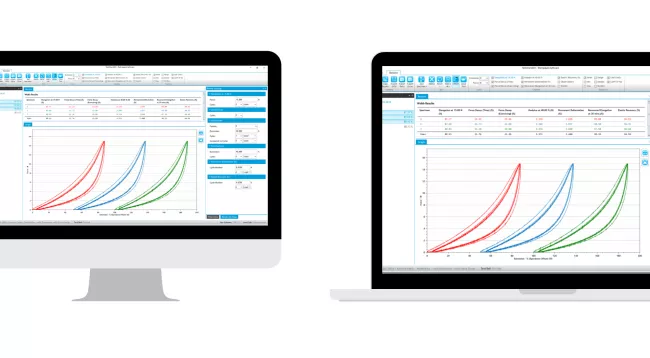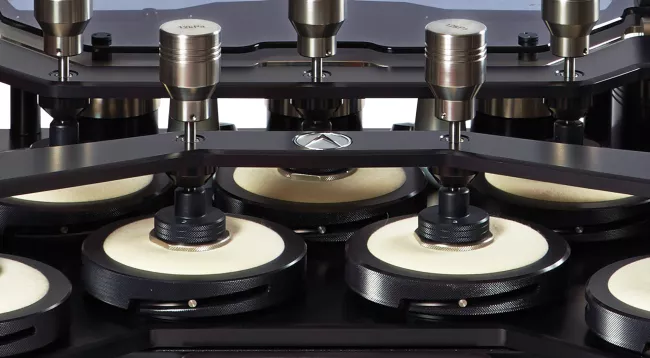The purpose of this guide is to help technicians and lab managers in independent laboratories and in-house factories to better understand Performance Testing for technical textiles such as sportswear, activewear, outerwear and protective workwear, why you need to know about it, and how it will benefit your organisation. What you will learn:
- The key trends that are driving the industry
- How to test functional, technical and performance-based fabrics
- Understand which are the appropriate standards and test methods
- Decide on the right type of testing instrument and reference materials
- Gain a better understanding of this growing area of materials testing, to enable your company to win new clients by demonstrating your knowledge and expertise of their requirements
What's in this guide - quick links:
What's driving demand for Performance Testing?
Performance Testing is nothing new. Brands across the globe who specialise in functional and performance fabrics - such as sportswear and outerwear - have been conducting performance testing in their R&D and quality control laboratories for decades. But we now see much more demand for performance testing to be conducted by independent labs, as well as in-house labs within garment manufacturers' factories.
Athleisure: The perfect pairing of fashion and function
The sportswear industry has influenced mainstream fashion in a tremendous way, through the growth of 'Athleisure wear', with the commercialisation of sport, and influencer marketing. In a presentation delivered by Lycra at an ASBCI conference, 'Athleisure' was described as 'Fibre Technology To Fashion Trend' and a 'lifestyle being adopted around the world'. This trend continued on an upward trajectory ever since with people working from home and more casual attire being adopted in place of more traditional office wear.
Subsequently there have been significant advances in the design of protective workwear through the use of technical textiles to provide the wearer with greater comfort as well as protection. The shift continues with fashion and sports brands also entering the market for producing more fashionable yet functional workwear.
Athleisure is more than a trend. It is a lifestyle shift represented through a blend of sports, urban and fashion trends. Due to innovations in textiles and technology, improvements have been made in functionality. Its broad appeal means that almost everyone is a potential athleisure consumer.
This has an effect all the way down the supply chain, as fast-fashion brands, supermarket clothing retailers and high street retailers have started - and want to introduce more of these types of clothing into their product ranges to meet growing consumer demand. Fashion gives sports apparel credibility and sports gives fashion functionality For consumers, the wide appeal of this type of clothing is that the garments are designed to deliver technological benefits, as well as outstanding comfort and fit. Another important factor in athleisure is 'style' - so comfort, performance and appearance are what appeals to the people who wear them. The same can now be said for workwear.
Authentic sportswear brands, created by sports practitioners, function effectively but have often lacked aesthetic awareness and style. Performance sportswear design requires an approach where both form and function meets the needs of the end-user.
Introduction to Performance Testing: what it is and how it differs from traditional textile testing?
Before we can define 'Performance Testing' we need to take a look at the broader term - 'technical textiles'. Below is an excerpt from the Handbook of Technical Textiles: 'The search for an all-embracing term to describe these textiles is not confined to the words 'technical' and 'industrial'. Terms such as 'performance textiles', 'functional textiles', 'engineered textiles' and 'high-tech textiles' are also used in various contexts, sometimes with a relatively specific meaning - for example, 'performance textiles' is a term frequently used to describe the fabrics used in activity clothing.' Technical textiles is an all-encompassing term, covering a wide array of industries - from medical, agriculture, construction to automotive. The term 'Performance Textiles' is more often used to describe sportswear and activewear. Indeed, the largest technical textiles event, Techtextil, breaks down the term 'technical textiles' into 12-13 core areas:
- Agrotech: agriculture, aquaculture, horticulture and forestry
- Buildtech: building and construction
- Clothtech: technical components of footwear and clothing
- Geotech: geotextiles and civil engineering
- Hometech: technical components of furniture, household textiles and floor coverings
- Indutech: filtration, conveying, cleaning and other industrial uses
- Medtech: hygiene and medical
- Mobiltech: automobiles, shipping, railways and aerospace
- Oekotech: environmental protection
- Packtech: packaging
- Protech: personal and property protection
- Sportech: sport and leisure.
- Smartech: wearable textiles, e-textiles
For the purpose of this guide, we will be focusing on the 'Sportech' category:
Defining 'performance': function over appearance
Compared with mainstream fashion garments, which are about aesthetic appearance or decorative characteristics, performance fabrics have a primarily technical / functional benefit such as 'comfort', for example, keeping the wearer warm/cool/dry by regulating the body temperature, and/or 'safety' by protecting the wearer from the environment, and hazards such as fire-proofing the outer layer of the garment. Some examples of sportswear, activewear and outdoor wear applications include snowsuit, ski clothing, cycling shorts, gym wear, waterproof clothing for hiking, and so on. The list is quite literally endless! Protective workwear and clothing comes in various types, such as heat and radiation protection for firefighter garments, molten metal protection for welders, stab protection and bulletproof vests for police, high visability clothing, and even spacesuits for astronauts.
Sports apparel, driven by innovation in fibres, fabrics and garment manufacturing techniques, enables the athlete to 'feel good' which, in turn, promotes better performance.'
Properties of performance
In sports performance clothing, the term 'protection' has expanded to embrace abrasion resistance, insulation, tear strength, waterproofing, windproofing and, most recently, antibacterial and anti-UV properties. Furthermore, comfort and functionality, appearance and trends, influenced by fashion and the culture of the end-user, are important elements too. Based on the functional benefits of 'comfort' and 'safety' the most common properties of performance clothing are listed below (but this list is always growing due to new innovations in textile and fibre technologies):
| Property Performance | Fabric Requirements | Example end uses | Related Test Methods |
|---|---|---|---|
| Fit comfort | Support, stretch, stretch recovery | Sports / Activewear: particularly close fitting garments worn next to the skin e.g. base layers | Stretch and recovery Burst resistance |
| _ | _ | _ | _ |
| Moisture Management | Wicking, quick-drying | Sports / Activewear: particularly garments worn next to the skin e.g. base layers and undergarments | Horizontal wicking Vertical wicking Drying rate |
| _ | _ | _ | _ |
| Water Repellency | Surface repellency to wetting | Sports / Activewear: especially garments intended for wear in wet/rainy conditions e.g. outdoor coats | Spray rating Oil/liquid drop Bundesmann |
| _ | _ | _ | _ |
| Water Resistance | Resistance to water penetration (fabric and seams) | Sports / Activewear: especially garments intended for wear in wet/rainy conditions e.g. outdoor coats and overtrousers | Hydrostatic head Bundesmann |
| _ | _ | _ | _ |
| Breathability | Water vapour transmission (fabric and seams) | Sports / Activewear: e.g. base layers, outdoor coats | Upright cup Inverted cup Sweating guarded hot plate (Ret) |
| _ | _ | _ | _ |
| Thermal Resistance | Retention of heat produced by the body | Sports / Activewear: especially garments intended for wear in cold conditions e.g. fleeces and down jackets | Tog Sweating guarded hot plate (Rct) |
| _ | _ | _ | _ |
| Wind Proofing | Resistance to penetration by wind/air | Sports / Activewear: especially garments intended for wear in windy conditions e.g. outdoor coats and cycling wear | Air permeability |
| _ | _ | _ | _ |
| Ultraviolet Protection | Blocking of sun's UV rays | Sports / Activewear: garments intended for wear in sunny conditions e.g. base layers and swimwear | UV transmission/blocking |
| _ | _ | _ | _ |
| Anti-bacterial & Odour Control | Prevention of/resistance to odour causing bacteria | Sports / Activewear: particularly garments worn next to the skin e.g. base layers and undergarments | Agar plate Colony count |
The 'functionality' of a performance textile can be added in different ways. For example, 'Wicking' properties can be added:
- To the fibre content
- To the yarn or unfinished/undyed material
- By adding chemical finishes to the finished material
The science behind performance clothing Fundamentally, performance clothing is about the needs of the human body - primarily thermal regulation and comfort. Clothing acts as a barrier between the skin and the external environment - so it's important that the fabric does not restrict the skin/body's natural mechanisms for maintaining physiological comfort.
The layering system
In sportswear, and especially outdoor wear, a three layer clothing system is often advocated, with each layer in the system performing a different function which complements the whole for maximum comfort. 'The 'layering system' is becoming more tailored and refined with advances in textile technology and garment construction. For example, stretch yarns in knitted and woven construction, seamfree technology, moulded components and light-weight body armour and abrasion-resistant materials take advantage of modern fibre properties to provide ease of movement, appropriate cut and fit, and personal protection as required for specific end-use.' A layering system typically includes:
- Base layer (commonly referred to as the 'second skin') - worn directly next to the skin and should effectively manage liquid moisture from perspiration
- Mid layer - provides majority of insulation by trapping and storing warmed air
- Outer protective shell layer - must provide protection against environmental factors such as wind, rain, fire, tear and abrasion
Testing each layer
Skin layer - moisture management The skin layer is that which is in contact with the skin, e.g. base layers and under garments. The main function of this layer is to effectively manage moisture. This layer should promote rapid and wide distribution of liquid perspiration to allow it to evaporate - this is the body's natural mechanism for cooling and if the fabric restricts this it can cause overheating with potentially very dangerous consequences. Equally, if the fabric is not able to adequately dry, moisture retained can contribute to a post-exercise chill sensation once activity has stopped and the body's heat production is reduced. Testing for moisture management properties include two main types: tests for absorption/distribution of liquid moisture within a fabric or wicking; and tests for rate of drying i.e. evaporation of liquid moisture from a fabric. Tests for absorption/distribution of liquid moisture:
- BPI 1.2.1 Liquid sweat transport and liquid sweat buffering
- AATCC 79 Absorbency of textiles
- AATCC 197 Vertical wicking of textiles
- AATCC 198 Horizontal wicking of textiles
- AATCC 195 Liquid moisture management properties of textile fabrics
Tests for drying/evaporation:
- AATCC 199 Drying rate of textiles: Moisture analyser method
- AATCC 200 Drying rate of textiles at their absorbent capacity: air flow method
- AATCC 201 Drying rate of fabric: Heated plate method
As well as liquid moisture management, water vapour transmission performance also influences the comfort of this layer and can also be tested by a range of different methods. Tests for water vapour transmission:
- ASTM E96 Standard test method for water vapour transmission of materials
- ASTM F1868 Standard test method for thermal and evaporative resistance of clothing using a sweating hot plate
- BS EN ISO 15496 Textiles - Measurement of water vapour permeability of textiles for the purpose of quality control
- BS EN ISO 11092 Textiles - Physiological effects - Measurement of thermal and water-vapour resistance under steady-state conditions (sweating guarded-hotplate test)
- AATCC 204 Water vapor transmission of textiles: Method overview and recommended applications
- Hohenstein Watson method
- EMPA Sweating cylinder method
This layer also often includes some kind of odour control function. This might be in the form of an antimicrobial finish or by selection of naturally antimicrobial fibres (such as merino wool) - this limits the production or release of odour causing microbes in the fabric. Tests for antimicrobial effectiveness:
- BS EN ISO 20645 Textile fabrics - Determination of antibacterial activity - Agar diffusion plate test
- BS EN ISO 20743 Textiles - Determination of antibacterial activity of textile products
- DIN EN 14119 Testing of textiles - Evaluation of the action of microfungi
- AATCC 30 Antifungal activity, assessment on textile materials: Test III and IV
- AATCC 90 Antibacterial activity assessment of textile materials: Agar plate method
- AATCC 100 Antibacterial finishes on textile materials
- AATCC 147 Antibacterial activity assessment of textile materials: Parallel streak method
- ASTM E2149 Standard test method for determining the antimicrobial agents under dynamic contact conditions
- ISO 13629-1 Textiles - Determination of antifungal activity of textile products - Part 1: Luminescence method
- ISO 13629-2 Textiles - Determination of antifungal activity of textile products - Part 2: Plate count method
- JIS L 1921 Textiles - Determination of antifungal activity and efficacy of textile products
- JIS L 1902 Textiles - Determination of antibacterial activity and efficacy of textile products
Mid layer - insulation The mid layer provides the majority of the thermal insulation in the system and is therefore particularly relevant for cold environments. This is often a fleece or down garment. The level of insulation required depends on the heat exchange between the human body and the environment, and therefore varies depending on activity and environmental conditions. For maximum thermal insulation, this layer should ideally have high loft - either in the pile of the fleece or the plume of the down feathers - in order to maximise the amount of air trapped within the system for retention of heat. Testing for thermal insulation is typically performed by heated hot plate or thermal manikin methods. Heated hot plate methods:
- ISO 5085 -1 Textiles - Determination of thermal resistance - Part 1: Low thermal resistance
- ISO 11092 Textiles - Physiological effects - Measurement of thermal and water-vapour resistance under steady-state conditions (sweating guarded-hotplate test)
- BS 4745 Determination of the thermal resistance of textiles - Two-plate method: fixed pressure procedure, two-plate method: fixed opening procedure, and single-plate method
- ASTM F1868 Standard test method for thermal and evaporative resistance of clothing materials using a sweating hot plate
Manikin methods:
- ISO 9920 Ergonomics of the thermal environment - Estimation of thermal insulation and water vapour resistance of a clothing ensemble
- ISO 15831 Clothing physiological effects - Measurement of thermal insulation by means of a thermal manikin
- ASTM F1291 Standard test method for measuring the thermal insulation of clothing using a heated manikin
- ASTM F2732 Standard practice for determining the temperature ratings for cold weather protective clothing
Air permeability also affects the thermal insulation performance of fabrics and so this might be tested on mid layer garments. Air permeability testing can also be used to give an indication of the density and therefore down-resistant performance of down-proof fabrics if they are present in this layer. Tests for air permeability:
- BS EN ISO 9237 Textiles - Determination of permeability of fabrics to air
- ASTM D 737 Standard test method for air permeability of textile fabrics
Outer layer The outer layer garment provides protection against the external environment. In the context of sports and outdoor wear this typically means protection against foul weather conditions namely rain, snow and wind. For the outer layer to be most effective, it should demonstrate high levels of water resistance without impeding the comfort of the wearer. A completely waterproof outer layer would not be effective as it could cause excessive sweating resulting in moisture collecting within the clothing system causing reduced insulation and comfort. An effective outer layer should have a high level of water resistance as well as a high level of water vapour permeability (or 'breathability'). 'Creating a fabric which provides good water resistance is relatively easy but doing this without compromising breathability is difficult as these two properties have an inverse relationship in typical textiles'. The outer layer itself is often a layered construction consisting of a waterproof breathable membrane laminated to a water repellent outer fabric and often with the addition of an inner layer which provides protection for the membrane and can also be designed to promote moisture wicking therefore further enhancing wearer comfort. The waterproof breathable membrane is able to resist liquid water penetration whilst still permitting the transmission of water vapour. This can be achieved by a number of different mechanisms including hydrophobic microporous membrane - thin film containing lots of fine holes to allow passage of water vapour; hydrophilic membrane - mechanism of absorption, diffusion and desorption of water vapour; bicomponent - combination microporous film with additional hydrophilic/oleophobic coating. Testing for the outer layer can be divided into water resistance/repellency tests, water vapour permeability tests, and air permeability tests. Tests for water resistance/repellency: Static repellency tests:
- Water contact angle - Goniometer system - sessile drop method and contact angle hysteresis method
- BS EN ISO 23232 Aqueous liquid repellency. Water/alcohol solution resistance test
- AATCC 193 Aqueous liquid repellency. Water/alcohol solution resistance test
- BS EN ISO 14419 Textiles - Oil repellency. Hydrocarbon resistance test
- AATCC 118 Oil repellency: Hydrocarbon resistance test.
Dynamic repellency tests:
- BS EN ISO 4920 Textile fabrics - Determination of resistance to surface wetting (spray test)
- AATCC 22 Water repellency - Spray test
- BS EN ISO 29865 Determination water repellency of fabrics by the Bundesmann rain-shower test
Water resistance tests:
- ISO 22958 Textiles - Water resistance - Rain tests: exposure to horizontal water spray
- BS EN ISO 18695 Textiles - Determination of resistance to water penetration. Impact penetration test
- AATCC 42 Water resistance: Impact penetration test
- BS EN 20811 ISO 811 Textiles - Determination of resistance to water penetration - Hydrostatic pressure test
- AATCC 127 Water resistance: Hydrostatic pressure test
- AATCC 35 Water resistance: Rain test
- NWSP 80.6 Water resistance (hydrostatic pressure)
Tests for water vapour permeability:
- ASTM E96 Standard test method for water vapour transmission of materials
- ASTM F1868 Standard test method for thermal and evaporative resistance of clothing using a sweating hot plate
- BS EN ISO 15496 Textiles - Measurement of water vapour permeability of textiles for the purpose of quality control
- BS EN ISO 11092 Textiles - Physiological effects - Measurement of thermal and water-vapour resistance under steady-state conditions (sweating guarded-hotplate test)
- AATCC 204 Water vapor transmission of textiles: Method overview and recommended applications
- Hohenstein Watson method
- EMPA Sweating cylinder method
Manikin methods for water vapour permeability:
- ASTM F 2370 Evaporative resistance of clothing using a sweating manikin
Tests for air permeability:
- BS EN ISO 9237 Textiles - Determination of permeability of fabrics to air
- ASTM D 737 Standard test method for air permeability of textile fabrics
Challenges of Performance Testing
Understanding the context of the testing can be a challenge to understanding and interpreting the results. For example, if you're working in a commercial lab and you have to do a stability to washing test or a colour fastness test, you can understand the context because you wash your clothes at home, and so the purpose of the test and its results make sense. This might not be the case when testing performance properties such as wicking; without the context of the end use and how this property influences the wearer, it might be more difficult to understand the importance of the test. Educating your laboratory technicians in this area would be valuable to increase comprehension. The good news is that testing for performance fabrics can take place in the same lab environment as standard fabric testing, so no special adjustments to the lab are needed. Substantiating claims as a true measure of performance If a retailer is making a specific claim about functionality, then this is usually to give the garment a more premium price point. However, this functionality has been qualified by evidence to prove the claim - which is where Performance Testing comes in. As a laboratory, if a retailer approaches you because they are introducing a new performance clothing or athleisure range, then they will be expecting you to validate and substantiate the claims they want to make on those garments - for example, moisture control and breathability. There is legislation in the UK, EU and the USA to protect consumers from false advertising, so it's crucial that retailers and brands can back up the claims being made on the swing tickets. This legislation includes:
- Consumer Protection From Unfair Trading Regulations (Trading Standards Office, UK)
- Truth in Advertising Legislation (in most EU member states)
- Federal Trade Commission (FTC) in the USA, which governs the labelling of products.
Choosing the right laboratory instruments
Factors to consider when choosing instruments to carry out the testing above include:
- Accuracy - is the instrument conducting the test in the most accurate way possible, does the software represent the results in an accurate way?
- Repeatability - if my laboratory and a laboratory in another country test the same samples in the same conditions, will this instrument provide the same results?
- No need for operator training - can my laboratory technicians operate this instrument with ease, are results easy to calculate and analyse?
- Standards compliance - does this instrument test to the standards I require, and is there potential to include other standards in the future?
James Heal launched the first four instruments of the Performance Testing range in 2019 followed by a further two in 2021. These instruments are AquAbrasion Wet Abrasion Tester, ProDry Dry Rate Tester, TruRain Water Repellency Tester, WickView Moisture Management Tester, AirPro Air Permeability Tester and HydroView HydroStatic Head Tester.
Final Thoughts
Garment manufacturers and factory labs, as well as independent laboratories across the world, have a significant opportunity to win new business contracts with new and established sports and performance wear brands/retailers. By demonstrating knowledge of this rapidly growing area of materials testing, and by making an investment in the right type of testing instruments for your lab, you're demonstrating your commitment to supporting your target customers' growth as a brand and retailer in the performance textiles space. Contact us if you would like further information on Performance Testing.
Sources:
- 'Proving Performance' - a presentation delivered by Helen Colebourn at Bureau Veritas, ASBCI Conference 2019
- Techtextil Trade Show Website - 'The 12 application areas of technical textiles'
- Ruckman, J.E., 2005b. 'The application of a layered system to the marketing of outdoor clothing'. Journal of Fashion Marketing and Management, 9, p.122-129.
- https://www.ukclimbing.com/articles/features/waterproof_breathable_fabric_-_explained-4556
Glossary
- Thermal insulation - the resistance to heat transfer by convection and radiation by clothing layers. It accounts for the resistance to heat exchange in all directions and over the whole body surface. It is an average of covered as well as uncovered body parts. This unique definition allows the introduction of clothing in the heat balance equation. (Interpreted from: Science Direct)
- Evaporative resistance - the resistance to heat transfer by evaporation and vapour transfer through clothing layers. As for insulation, it also refers to the whole body surface. In reality, the property is a resistance to vapour transfer. Heat transfer takes place only when sweat evaporates at the skin and is transported to the environment by diffusion or convection. (Interpreted from: National Centre for Biotechnology Information)
- Performance testing - the physical testing of materials with a focus on function rather than aesthetic appeal.
- Technical textiles - A technical textile is a textile product manufactured for non-aesthetic purposes, where function is the primary criterion. (Source: Techtextil website)
Find out more about our new Performance Testing Range here:












